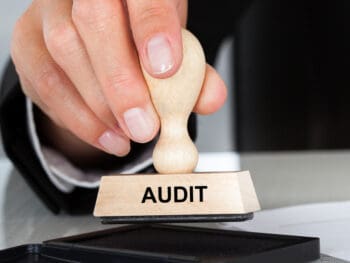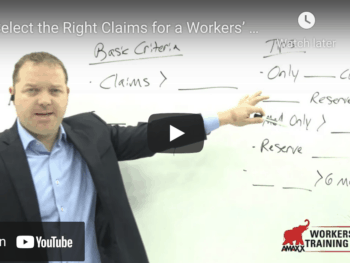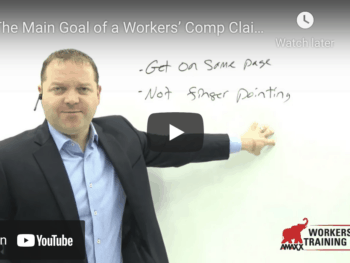While every workers’ compensation claim is unique, every claim contains certain key events and documents. The best practices established either by the insurer or the third party administrator creates a certain amount of uniformity in the claims.
When you review the workers’ comp claims of your employees, you will see established criteria in the handling of the claims. Each claim will contain information on:
Click Link to Access Free PDF Download
“Workers’ Comp Claims Review Checklist: 9 Must-Have, Serious-Impact Elements”
- Coverage
- Contacts
- Investigation
- File Documents
- Evaluation and Settlement
Coverage:
The very first step the adjuster takes when handling a claim is the verification that there is coverage. This includes checking the policy number to be sure it is accurate; the policy dates to be sure the injury occurred during the time frame covered by the policy; the state(s) covered by the policy; and, any endorsements to the policy or any exclusions of coverage. If any aspect of the coverage verification is missing, the wise adjuster stops any further activity on the file until there is proof insurance covers the claim.
Contacts:
Once the workers’ comp adjuster verifies there is insurance coverage in effect for the named insured, on the date of the injury, and in a location covered by the policy, the adjuster contacts all involved parties. Whether the adjuster contacts the injured employee first or the employer first depends on the nature and extent of the injury and the time frame of known events. The adjuster also contacts the medical provider’s office to obtain the initial medical treatment information, to provide information to the medical provider on billing for their services, and to provide the medical provider with information on the return to work policy of the employer. Any other parties who may impact the claim are also contacted; for example — witnesses on questionable or severe claims.
Investigation:
Contact with all parties involved is the start of the claim investigation, but a proper investigation contains many other actions impacting the future outcome of the claim. Some of the investigation steps include:
- A comparison of the details of the accident as provided by the employer, the employee, the medical provider, and any witnesses. Any deviation in the information obtained from the various parties needs to be analyzed by the adjuster.
- The filing of the Insurance Service Office inquiry to determine if the employee has made prior insurance claims, and if so, do they impact the present workers comp claim. For instance, the employee, who suffered a lower back strained in your claim, also had a lower back injury workers comp claim with a previous employer.
- A determination if there is a third party responsible for the employee’s injury, and if so, the documentation needed to pursue a subrogation claim.
- An analysis of the nature and extent of the employee’s injury, the medical treatment plan, and the prognosis for the employee’s recovery.
- An analysis of the employee’s job duties, equipment used, the return to work restrictions from the medical provider and the modified duty information obtained from the employer to determine if a modified duty job is an option.
- A determination as to the future course of action needed on the file, also known as an Action Plan.
File Documents:
Every claim file has basic claim documents to support the claim and the activity taken on the claim. Depending on the extent of the injury, the file may have additional documentation that might not be found in a simple injury claim. The documents you may see in the claim file include:
- The Employer’s First Report of Injury (FROI).
- The recorded statement summary of the employee and possibly the recorded statement summary of the employee’s supervisor and/or witnesses.
- The required state forms filed with the governmental office enforcing the workers’ compensation statutes of the state.
- The wage statement is showing the employee’s earnings during the required calculation period.
- The Insurance Service Office report.
- The medical records.
- Vocational and/or rehabilitation reports.
- Subrogation documentation.
- Correspondence to and from defense counsel, correspondence to and from the employee’s attorney, and correspondence between defense counsel and the employee’s attorney.
- Reserve worksheets used to calculate the cost of the claim.
- File notes (a log of activities undertaken) making a record of every telephone call, piece of mail, e-mail, fax or other communication on the claim.
Evaluation and Settlement:
When the claim file has progressed to the point where the adjuster can start the evaluation process (usually when the employee has reached maximum medical improvement); there will either be a reserve worksheet or an evaluation worksheet establishing the financial exposure of the claim. The evaluation of the claim includes the compensability, the disability rating, the jurisdictional law, and any legal questions that need to be resolved. The file notes should describe the adjuster’s settlement discussions when they have taken place.
An essential part of risk management is to know as much as possible about the exposures your company faces. We recommend obtaining electronic access (on a read-only basis) to the insurer’s or third party administrator’s claim file. By knowing what is in your claim file, you can contribute any additional information benefiting the adjuster in bringing your employee’s workers’ comp claim to a satisfactory conclusion.

Author Michael Stack, CEO Amaxx LLC. He is an expert in workers’ compensation cost containment systems and helps employers reduce their workers’ comp costs by 20% to 50%. He works as a consultant to large and mid-market clients, is a co-author of Your Ultimate Guide To Mastering Workers Comp Costs, a comprehensive step-by-step manual of cost containment strategies based on hands-on field experience, and is founder & lead trainer of Amaxx Workers’ Comp Training Center .
Contact: mstack@reduceyourworkerscomp.com.
Workers’ Comp Roundup Blog: https://blog.reduceyourworkerscomp.com/
©2018 Amaxx LLC. All rights reserved under International Copyright Law.
Do not use this information without independent verification. All state laws vary. You should consult with your insurance broker, attorney, or qualified professional.
















